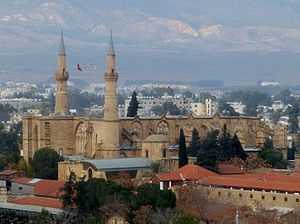Selimiye Mosque, Nicosia
| Selimiye Mosque | |
|---|---|
 | |
 The location of Selimiye Mosque in Cyprus
| |
| Basic information | |
| Location | Nicosia |
| Geographic coordinates | 35°10′35″N 33°21′52″E / 35.176496°N 33.364478°ECoordinates: 35°10′35″N 33°21′52″E / 35.176496°N 33.364478°E |
| Affiliation | Islam (Roman Catholic Cathedral - 1209-1570) |
| District | Nicosia District |
| Architectural description | |
| Architectural style | Gothic |
| Completed | 1209 |
| Specifications | |
| Minaret(s) | 2 |
Selimiye Mosque (Turkish: Selimiye Camii), also known as Agia Sofia Cathedral (Greek: Καθεδρικός Αγίας Σοφίας), formerly Cathédrale Sainte Sophie, is a Mosque located in the Turkish-controlled northern part of the walled city of Nicosia. It is the main mosque of the city.
History
The Selimiye Mosque is housed in the largest and oldest surviving gothic church in Cyprus (interior dimensions: 66 X 21 m) possibly constructed on the site of an earlier Byzantine church. The building belongs to the pure Gothic style of the beginning of the 12th century. Due to the building’s large scale, lack of money and various historical events it took 150 years for the cathedral to be built and still, it was never completed since the southwest tower and the portico’s upper floor were not constructed.
The cathedral’s first construction phase began during the first years of Frankish rule (possibly in 1209) and by 1228 the eastern part of the building was completed. By the end of the 13th century the side aisles and a large part of the middle aisle were completed. From 1319 to 1326 the Latin archbishop of Nicosia Giovanni del Conte or Giovanni de Polo was responsible for the completion of the middle aisle, the construction of the roof buttresses, the cathedral’s façade and the building of a chapel (which functioned as a baptistery) in the western part of the southern wall. He also adorned parts of the cathedral with frescoes and sculptures. In November 1326 the cathedral’s official inauguration took place.
Even though the cathedral was inaugurated, the building was still incomplete and in 1347 Pope Clement IV issued a papal bull for the cathedral to be completed and renovated since it had been affected by an earthquake. It was during this construction period that the building’s portico and the northwest tower were constructed. The western wall’s three entrances are decorated with important examples of architectural sculpture. The main entrance’s frame bears impressive sculptures. Three of the four arches are decorated with reliefs depicting kings, prophets, apostles and bishops.
With Nicosia's occupation by the Ottomans (1570), the cathedral of Agia Sofia was turned into a mosque and two minarets were added onto the building’s west part. The cathedral’s rich sculptural decoration was destroyed and so were the frescoes, the sculptures and the stained glass decoration (vitraux) depicting scenes from the Old and New Testament. Funerary tombstones of various Lusignan kings and princes were also destroyed.
In August 1954 the monument was renamed the Selimye mosque in honor of sultan Selim II (1566 – 1574) who ruled at the time of Cyprus’ conquest by the Ottomans.
Gallery
-

Saint Sophia Cathedral, eastern view
-

See also
External links
| Wikimedia Commons has media related to Category:Selimiye Mosque (St. Sophie Cathedral). |